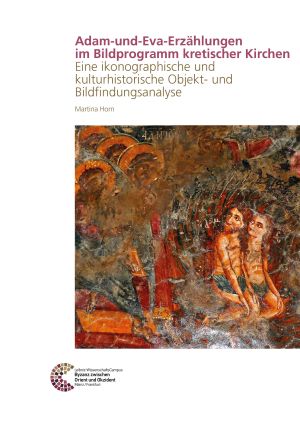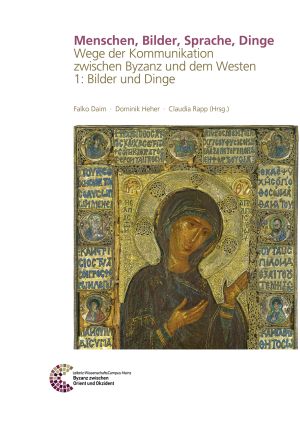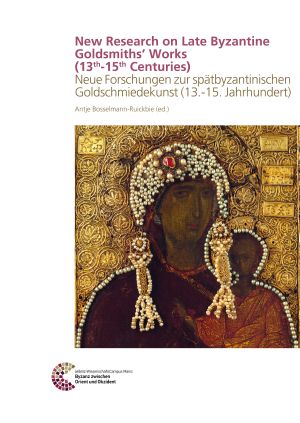Horn, Martina
Adam-und-Eva-Erzählungen im Bildprogramm kretischer Kirchen: Eine ikonographische und kulturhistorische Objekt- und Bildfindungsanalyse
The Western sacred art landscape of the Middle Ages presents a rich pageantry of images about the Adam and Eve story by using overlapping genres. In the large-scale paintings of the Eastern Church, on the other hand, the subject is only included in the repertoire of the churches during the post-Byzantine period. Thus, the innovative origins of Adam and Eve cycles in Venetian Crete of the 14th and 15th centuries, are even more remarkable. In five of the numerous painted Cretan churches, pictorial sequences with Adam and Eve were integrated into the iconographic concept. Beside the reconstruction of the partially destroyed frescoes, the comprehensive process of the iconographic invention will be subject of a detailed examination in this study, based on art- and cultural-historical analysis. The genesis of the wall paintings is characterized by a strong tension and a dynamic interplay between the preservation of traditional and available patterns and the inventiveness of innovative and creative elements. The broadly diversified research including Western and Eastern art traditions offers not only surprising insights into unusual pictorial formulas, but also in the varying reasons of reception in relation to the donors and their specific motivation.
Menschen, Bilder, Sprache, Dinge: Wege der Kommunikation zwischen Byzanz und dem Westen 1: Bilder und Dinge
In 2018, the Roman-Germanic Central Museum Mainz presents in cooperation with the Schallaburg, the splendid Renaissance castle near Melk (Lower Austria), the exhibition »Byzantium & the West: 1000 forgotten years «.
Both Byzantium and the European West spring from the Roman Empire, but as early as Late Antiquity experience different developments. While the Roman Empire continued to exist in the East and passed seamlessly into the Byzantine Empire of the Middle Ages, pagan polities took its place in the West: the kingdoms of the Goths, Vandals, Anglo-Saxons, Lombards and Franks. Although Byzantium was respected or accepted as a major power by the other European entities for at least 800 years, territorial conflicts, disputes, and cultural differences quickly emerged. In addition, communication became increasingly difficult - in the "orthodox" East, Greek was the common language, while in the "Catholic" West, Latin was the lingua franca. Differences in liturgy and questions of belief intensified the disparities or were even (religio-) politically underlined to emphasize dissimilarity. But one still continued to admire "wealthy Constantinople" and the Byzantine treasures - among them the magnificent silks, ivory reliefs, technical marvels, plentiful relics and magnificent buildings.
The change came in 1204 with the conquest and plunder of Constantinople by the Crusaders. For the already weakened Byzantine Empire, this catastrophe meant a completely new situation as an empire in exile, whose emperor and patriarch had to flee to Asia Minor. Across much of the former European Byzantine Empire, crusader states spread; Venice and Genoa, which had previously been strongly present as trade powers under special treaties, became major determinants of the western powers in the East.
On the occasion of this exhibition, two accompanying volumes with a total of 41 contributions concerning the varied and changing relationships between the Latin West and the Byzantine Empire are being published. The volumes are structured according to the media of communication: people, images, language and things. They collect contributions from renowned scientists with archaeological, art historical, philological and historical priorities. Several overviews and detailed studies are drawn from research projects of the Leibniz- ScienceCampus Mainz: Byzantium between Orient and Occident, as well as the focus on Byzantine and medieval research of the Austrian Academy of Sciences in Vienna.
New Research on Late Byzantine Goldsmiths’ Works (13th-15th Centuries): Neue Forschungen zur spätbyzantinischen Goldschmiedekunst (13.-15. Jahrhundert)
This volume comprises 13 papers from the conference »New Research on Late Byzantine Goldsmiths‘ Works (13th-15th Centuries)«, held at the Römisch-Germanisches Zentralmuseum in Mainz in October 2015. The contributions primarily deal with the material culture of goldsmiths’ works, such as crosses, reliquary caskets, jewellery, enamel works, and precious stones, spanning the wide geographical area of Byzantium and many of its neighbours, from Russia via Trebizond and Serbia to Crete. Furthermore, written sources on Byzantine goldsmiths, their craft and the provenance of precious metals provide evidence for goldsmithing in Byzantium throughout its history.









